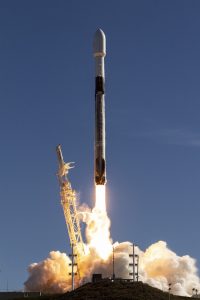Enoch is in orbit!
Today, a SpaceX Falcon 9 rocket carried a satellite called Enoch into orbit from Vandenberg Air Force Base.
I was there to witness the launch, from a distance of 5 miles. From that far away, we saw the “smoke and fire” a good ten seconds before the sound hit us. The rocket was a good 45 degrees up in the sky before a low rumbling roar washed over us, growing to a frighteningly loud crackle, culminating in a chest thumping sonic boom as the F9 broke the sound barrier. The rocket climbed into a clear blue sky, with its kerosene plume like an upside-down candle flame, and the sound gradually dimmed. We watched the stages separate, silently, and then saw the second stage ignite, like a bright spark floating upward into the sky.
Sometime after that, I lost sight of it. What I didn’t expect to see was the first stage re-light its engines, descend back into the atmosphere, and land on SpaceX’s drone ship 50 miles away! But sure enough, there it was – a bright orange spark, floating slowly down over the water, tiny but unmistakable to the naked eye. After days – really, months – of waiting, we got exceptionally lucky with our viewing conditions. Watching the Falcon 9 launch and land was an experience that I hope to repeat more than once in a lifetime.
The photo below isn’t mine – it’s one of SpaceX’s official launch photos. Everyone’s advice is: unless it’s literally your job to photograph the launch, you’ll have a much better experience if you just watch it, and experience. Everyone was right. At about T-4, I was still fumbling around with the drive mode on my camera – which would not have captured anything like this image, below, anyhow.

Not long after, we received confirmation that Spaceflight Industries’ SSO-A “Upper Free Flyer” was successfully in orbit, with Enoch stowed safely inside. This was a fantastic end to a nearly 2-year-long project. Later, watching the official SpaceX webcast of the launch, I was pleasantly surprised to hear the launch commendations mention Enoch by name. In fact, Enoch was the only satellite of the 64 on board that SpaceX actually called out this way!

